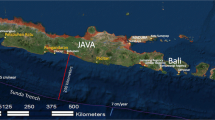Abstract
Tsunami education activities, materials, and programs are recognized by the National Tsunami Hazard Mitigation Program (NTHMP) as the essential tool for near-source tsunami mitigation. Prior to the NTHMP, there were no state tsunami education programs outside of Hawaii and few earthquake education materials included tsunami hazards. In the first year of the NTHMP, a Strategic Plan was developed providing the framework for mitigation projects in the program. The Strategic Plan identifies education as the first of five mitigation strategic planning areas and targets a number of user groups, including schools, businesses, tourists, seasonal workers, planners, government officials, and the general public. In the 6 years of the NTHMP tsunami education programs have been developed in all five Pacific States and include print, electronic and video/film products, curriculum, signage, fairs and workshops, and public service announcements. Multi-state education projects supported by the NTHMP include TsuInfo, a bi-monthly newsletter, and Surviving a Tsunami, a booklet illustrating lessons from the 1960 Chilean tsunami. An additional education component is provided by the Public Affairs Working Group (PAWG) that promotes media coverage of tsunamis and the NTHMP. Assessment surveys conducted in Oregon, Washington, and Northern California show an increase in tsunami awareness and recognition of tsunami hazards among the general population since the NTHMP inception.
Similar content being viewed by others
Abbreviations
- CSZ:
-
Cascadia Subduction Zone
- FEMA:
-
Federal Emergency Management Agency
- NOAA:
-
National Oceanic and Atmospheric Administration
- NTHMP:
-
National Tsunami Hazard Mitigation Program
- NWS:
-
National Weather Service
- PAWG:
-
Public Affairs Working Group
- WSSPC:
-
Western States Seismic Policy Council
References
Atwater, B. F., Cisternas, V. M., Bourgeois, J., Dudley, W. C., Hendley II, J. W., and Stauffer, P. H.: 1999, Surviving a Tsunami – Lessons from Chile, Hawaii, and Japan. USGS Circular 1187, 18 pp.
Atwater, B. F., Cisternas, V. M., Bourgeois, J., Dudley, W. C., Hendley II, J. W., and Stauffer P. H.: 2001, Sobreviviendo a un tsunami: lecciones de Chile, Hawai y Japòn. U.S. Geological Survey Circular 1218, 18 pp.
E. N. Bernard (1998) ArticleTitleProgram aims to reduce impact of tsunamis on Pacific states Eos, Trans. AGU 79 IssueID22 262–263
Dengler, L.: 1998, Strategic Implementation Plan for Tsunami Mitigation Projects, approved by the Mitigation Subcommittee of the National Tsunami Hazard Mitigation Program, April 14, 1998. Technical Report NOAA Tech. Memo. ERL PMEL-113 (PB99-115552), NOAA/Pacific Marine Environmental Laboratory, Seattle, WA. http://www.pmel.noaa. gov/pubs/PDF/deng2030/deng2030.pdf.
Dengler, L.: 2001, Tsunami mitigation efforts on California’s north coast. In: Proceedings of the International Tsunami Symposium 2001 (ITS 2001) (on CD-ROM), NTHMP Review Session, R-14, Seattle, WA, 7–10 August 2001, pp. 187–203. http://www.pmel.noaa.gov/its2001/.
L. Dengler K. Moley (1995) Living On Shaky Ground, How to Survive Earthquakes and Tsunamis on the North Coast. Humboldt Earthquake Education Center, Humboldt State University Arcata, CA 95521
F. I. González E. N. Bernard (1993) ArticleTitleThe Cape Mendocino Tsunami Earthquakes and Volcanoes 23 IssueID3 135–138
Good, J. W.: 1995, Tsunami Education Planning Workshop, Findings and Recommendations. NOAA Tech. Memo. ERL PMEL-106, 41 pp. (PB95-195970), NOAA/Pacific Marine Environmental Laboratory, Seattle, WA.
D. Johnston D. Paton G. Crawford K. Ronan B. Houghton P. Buergelt (2005) ArticleTitleMeasuring tsunami preparedness in Coastal Washington, United States. Nat. Hazards. 35 173–184
Johnston, D. M., Driedger, C., Houghton, B., Ronan, K., and Paton, D.: 2001, Children’s risk perceptions and preparedness: A hazard education assessment in four communities around Mount Rainier, U.S.A.–Preliminary results. Institute of Geological and Nuclear Sciences Science Report 2001/02.
Johnston, D. M., Paton, D., Houghton, B., Becker, J., and Crumbie, G.: 2002, Results of the August–September 2001 Washington State Tsunami Survey. Institute of Geological and Nuclear Sciences Science Report 2002/17, 35 pp.
Jonientz-Trisler, C. and Mullin, J.: 1999, 1997–1999 Activities of the Tsunami Mitigation Subcommittee: A Report to the Steering Committee NTHMP. FEMA Region 10 publication, 45 pp., Appendices.
C. Jonientz-Trisler R. S. Simmons B. Yanagi G. Crawford M. Darienzo R. Eisner E. Petty G. Priest (2005) ArticleTitlePlanning for communities at risk of tsunamis Nat. Hazards. 35 121–139
Karel, A.: 1998, Oregonians need more information about tsunamis to save lives (results of a survey). Oregon Geol. 60(3).
D. H. Oppenheimer G. Beroza G. Carver L. A. Dengler J. P. Eaton L. Gee F. González M. Magee G. Marshall M. Murray R. C. McPherson B. Ramanowicz K. Satake R. Simpson P. Somerville R. Stein D. Valentine (1993) ArticleTitleThe Cape Mendocino, California, earthquake of April 1992: Subduction at the triple junction. Science 261 433–438
Public Affairs Working Group (PAWG): 1998, National Tsunami Hazard Mitigation Program Tsunami Public Affairs Working Group Report Anchorage. http://www.pmel.noaa.gov/tsunami-hazard/pawgoctober98report.html.
Tsunami Hazard Mitigation Federal/State Working Group: 1996, Tsunami Hazard Mitigation Implementation Plan – A Report to the Senate Appropriations Committee, 22 pp., Appendices, http://www.pmel.noaa.gov/tsunami-hazard/hazard3.pdf.
Washington Military Department, Emergency Management Division: 2001a, Move To High Ground, Tsunami Curriculum Grades K–6. http://www.prh.noaa.gov/itic/library/pubs/curriculum/tsunami_curriculum. html, 68 pp.
Washington Military Department, Emergency Management Division: 2001b, Surviving Great Waves of Destruction. http://www.prh.noaa.gov/itic/library/pubs/curriculum/tsunami_curriculum.html, 52 pp.
Author information
Authors and Affiliations
Corresponding author
Rights and permissions
About this article
Cite this article
Dengler, L. The Role of Education in the National Tsunami Hazard Mitigation Program. Nat Hazards 35, 141–153 (2005). https://doi.org/10.1007/s11069-004-2409-x
Received:
Accepted:
Issue Date:
DOI: https://doi.org/10.1007/s11069-004-2409-x




